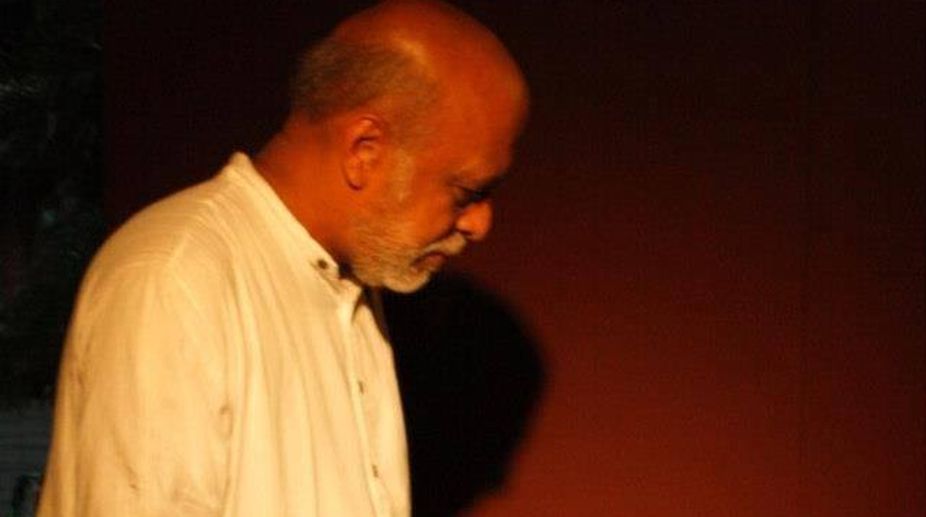Indian mythology and ancient Puranas are not made-up stories about Gods —they contain the universal truths about human nature and are timeless in their appeal, according to artist V Ramesh. His works have captured the attention of art aficionados for their distinctive narrative vocabulary rooted in our country’s sacred and literary culture.
The Vizag-based artist spoke about his style, inspirations, struggles and the stories that his canvases tell. He is among the rare artists who have successfully married abstraction and realism in their works, and he has distinguished himself in this group by integrating, “voices from poetry and imagery culled from mythology”.
Advertisement
“I don’t think time is a linear factor or that something should be more relevant to us now because we are living in the 21st century. Every idea is relevant to us because they affect us. Mythological stories are not about Gods, they are about human nature and the human psyche,” said Ramesh.
He referenced a painting of his called “The Thousand and One Desires” in which he depicted the legend of the God Indra after he is cursed to be covered with a thousand eyes for his lustfulness and greed. “Greed has been around there since time immemorial. We may be advanced technologically and socially, and yet humans still covet things that do not belong to them, that has not vanished; that is what the stories tell you. And it’s in all cultures, not just Indian. I don’t think the storytellers of old were trying to be moralistic, they were just telling you how things were; it is up to you to take what you want from it,” said Ramesh.
This timelessness, he said, was what he tried to explore in his own paintings; such as the one of Ashtavakra, whose story depicts the primacy of wisdom over physical beauty; or that of Karaikal Amma, a 5th Century Tamil poet who seeks a boon to be made so ugly that no man should ever desire her, and that she be freed from the bonds of physicality to roam the earth naked and write and recite her poetry.
His liberal use of verses from medieval women poets was another distinct feature of his works. Besides Karaikal Amma, he has also referenced the poetry of Akka Mahadevi, a 12th century Kannada poet; Lal Ded, the 14th century Kashmiri Mystic; and Andal, the great Tamil saint. His extraordinary discovery, he said, upon reading the works of these women separated by both time and geography was that they were essentially saying the same things. The words had the same resonance although the metaphors they used were distinct to their own cultures. Their stories, experiences and works were fascinating, he said, especially that of Andal “has so much of erotic overtones which people suppress”.
Andal’s father was supposedly a garland maker for the temple deity and as a young girl she would secretly wear these garlands before they were sent to the temple, which was sacrilegious. One day her father discovers the misdeed after finding a strand of her hair in the garland.
He makes a new one and puts it around the deity. In the night he gets a dream where Lord Vishnu tells him he misses the garland worn by the daughter because he misses the scent of her body. “This is beautiful,” added Ramesh.
“When people talk about devotion or bhakti it has overtones of eroticism and physicality which most people deny. That intimacy with the deity and the truth is evident even in the hymns of Akka Mahadevi. We seem to have lost that in our skeptical outlook to the world around us.” He decried the Indians’ general loss of “sensitivity” to surroundings.
“We have lost our sensuality, our capacity to be sensitive to the physical attributes of life around us, like a scent or touch. How many children these days would react to the smell of the first rain falling on dry earth? Many don’t even come out of their houses when it rains,” said Ramesh.
“Sometimes it is astounding,” he said,” to see that outer garb may change, but in essence, the way things are the way people are remains the same for centuries. Poetry and painting from ages ago can still be relevant. They have the ability to arouse emotions and move you, if you are open to it. The discussion also dwelt on his evolution as an artist capable of “speaking the languages of both abstract and realism without guilt”, his deep spiritual experience from a chance visit to the Ramana Ashram and his difficulties in working without an artistic precedent for including devotion, bhakti or ibadat in paintings in the manner that he has done.
Ramesh, who has also been teaching at the department of fine arts, Andhra University, Visakhapatnam, since 1985, spoke hopefully about the artistic spark and the spirit of inquiry among his students.











